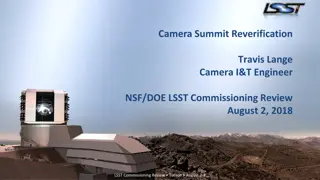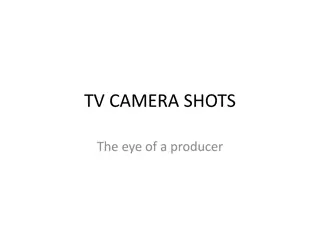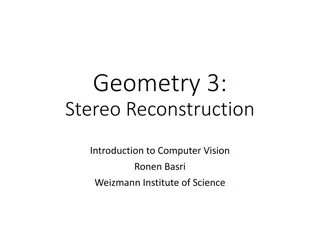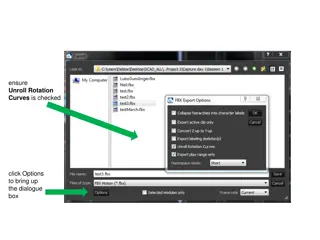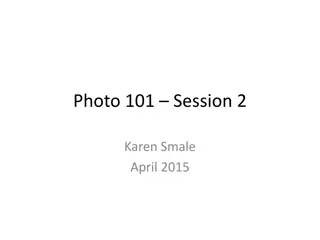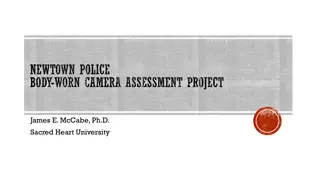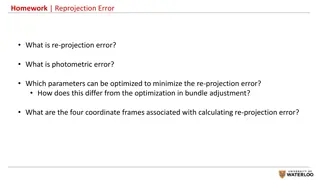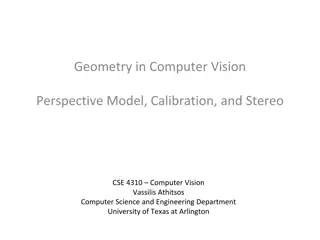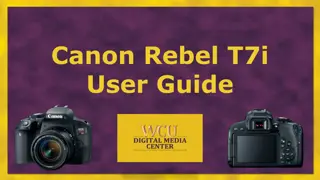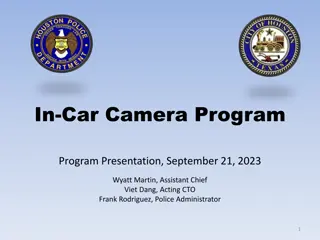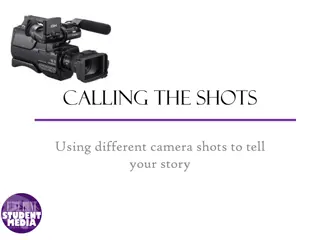Understanding the Essential Parts of a Camera
The camera consists of crucial components like the body, lens assembly, shutter release button, and mode dial. The body holds everything together, while the lens assembly controls focusing and zoom. The shutter release button triggers image capture, and the mode dial allows you to select different shooting modes such as portrait, sports, macro, and landscape. Each mode is designed to optimize the camera settings for specific types of photography.
Download Presentation

Please find below an Image/Link to download the presentation.
The content on the website is provided AS IS for your information and personal use only. It may not be sold, licensed, or shared on other websites without obtaining consent from the author. Download presentation by click this link. If you encounter any issues during the download, it is possible that the publisher has removed the file from their server.
E N D
Presentation Transcript
Parts of the Camera What Do They Do?
Parts of the Camera 1. Body 1. Body Made of high grade plastic or metal, this holds all the other parts together as well as provide protection to the delicate internal parts of the camera. 2. Lens Assembly 2. Lens Assembly This consists of several layers of lenses of varying properties providing zoom, focusing, and distortion correction. These lenses are mechanically interconnected and adjustment is controlled electronically by the camera's body.
Parts of the Camera 3. Shutter Release Button 3. Shutter Release Button - This is the "trigger" of the camera. In most cameras, a half-press activates and locks the auto-focus, and a full press initiates the image capturing process. 4. Mode Dial 4. Mode Dial - Contains several symbols (slightly different on various camera models), this dial allows you to select a shooting mode, automatic or manual or a choice between one of the pre-defined settings.
Mode dials Portrait Mode Portrait Mode Portrait mode works best when you re photographing a single subject When you switch to portrait mode your camera will automatically select a large aperture (small number) which helps to keep your background out of focus Use your built-in telephoto lens (your legs!) and get close to your subject If you have to shoot into the sun, trigger your flash so there won t be a shadow on their face
Mode dials Sports Mode Sports Mode Sports mode works best for photographing moving objects, such as sports, pets or cars When you switch to sports mode your camera will automatically freeze the action by increasing the shutter speed Try to pre-focus your camera where you think your subject WILL be
Mode dials Macro Mode Macro Mode Macro mode works best for photographing objects close up, such as flowers or insects When you switch to macro mode your camera automatically change your depth of field to very narrow, making focusing challenging A tripod is recommended to reduce blur A flash might be too bright this close to your subject
Mode dials Landscape Mode Landscape Mode Landscape mode works best for photographing landscapes or non-moving items at a distance, such as buildings When you switch to landscape mode your camera will automatically select a small aperture (large number) which helps to keep your background in focus A tripod is recommended to reduce blur
Parts of the Camera 5. Viewfinder 5. Viewfinder - A small viewing window that shows the image that the camera's imaging sensor sees. This can either be an optical view finder, which shows the actual image in front of the camera through a peep hole or through mirrors, or an electronic view finder which is simply a small LCD display.
Parts of the Camera 6. Aperture Ring 6. Aperture Ring - Found around the old manual lens of SLR camera, this is used to select an aperture opening. In modern lenses, the aperture is controlled electronically through the body. The aperture is the opening through which light travels to create an image. 7. Focusing Ring 7. Focusing Ring - This can also be found around the lens of a DSLR camera. This is turned to manually focus the lens.
Parts of the Camera 8. LCD Display 8. LCD Display - In some compact cameras this acts as the viewfinder. This is a small screen (usually 1.8" diagonally or bigger) at the back of the camera which can be used for framing or for reviewing the recorded pictures. LCD is an acronym for Liquid Crystal Display.
Parts of the Camera 9. Flash 9. Flash - Built-in on the body of most compact and some DSLR cameras this can either be fixed or flip type, it provides an instantaneous burst of bright light to illuminate a poorly lit scene.
Parts of the Camera 10. Control Buttons 10. Control Buttons - Usually includes a set of directional keys and a few other buttons to activate certain functions and menus, this is used to let users interact with the camera's computer system.
Parts of the Camera 11. Power Switch 11. Power Switch - Turns the camera On or Off. This may also contain a Record / Play Mode selector on some cameras.
Parts of the Camera 12. Zoom Control 12. Zoom Control - Usually marked with W and T, which stands for "Wide" and "Tele" respectively, this is used to control the camera's lenses to zoom-in or zoom-out. For DSLR cameras, the zoom is usually controlled by a zoom ring in the lens.
Parts of the Camera 13. Battery Compartment 13. Battery Compartment - Holds the batteries. Depending on the camera model, this varies in size and shape. 14. Memory Card Slot 14. Memory Card Slot - This is where expansion memory cards are inserted. The proper position of the card are often indicated. A mechanical catch usually holds the card in place and a spring helps it eject.
Parts of the Camera 15. Flash Mount 15. Flash Mount - Standard holder with contact plates for optional Flash accessory.
Parts of the Camera 16. 16. Diopter Diopter Adjuster compact cameras and DSLRs located besides the viewfinder. This varies the focal length of the lens in the viewfinder to make even people wearing eyeglasses to see clearly through it even without the eyeglasses. Adjuster - Usually available in mid to high end sub-
Parts of the Camera 17. Tripod Mount 17. Tripod Mount - Here is where your standard Tripod or Monopod is attached for added stability. A tripod has three legs while a monopod has one. Source: picture-thoughts.com






